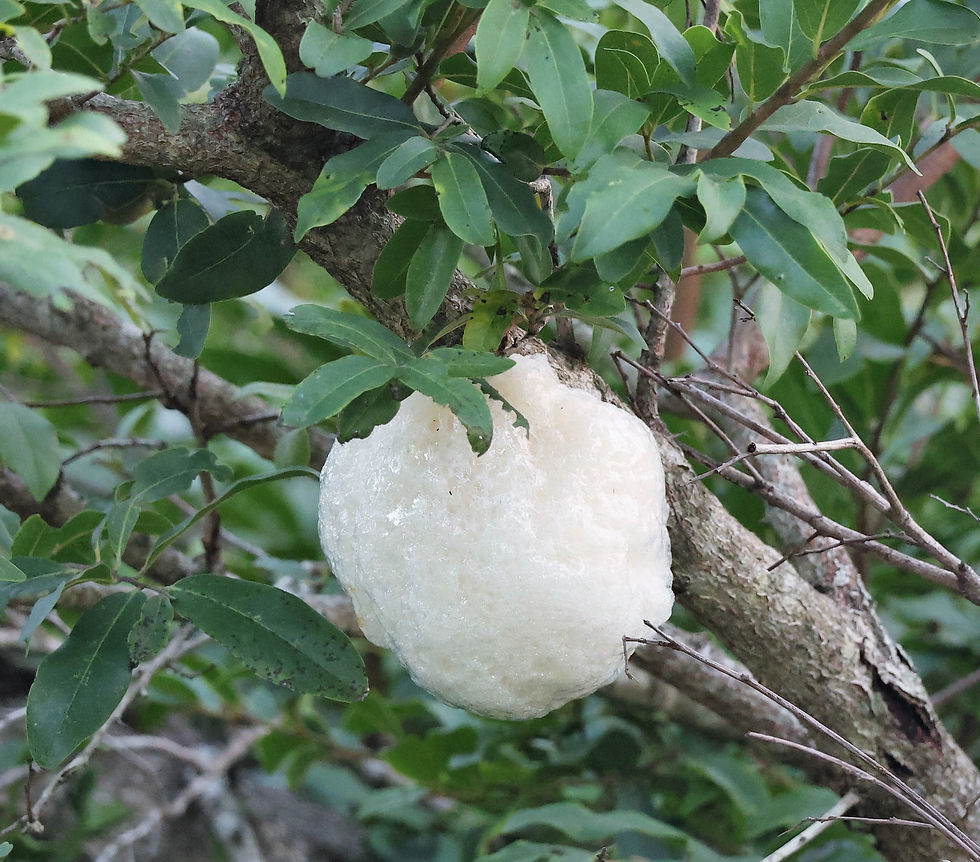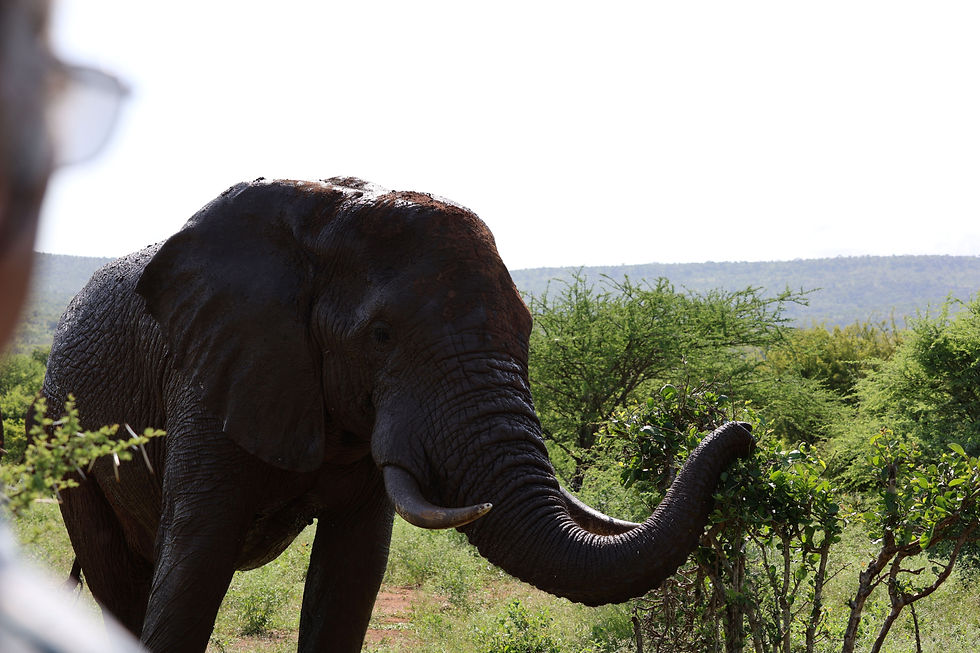March 9, 2023

Elephants were the stars this morning. We saw several groups of them throughout the morning browsing and grazing and sometimes posturing for the tourists. The curious baby elephant who tried to either communicate with us or intimidate us was my favorite. You can watch the video later in this entry.
The morning started out slow with few mammal sightings, but beautiful scenery and the opportunity to watch for birds in the road ahead, as well as perched on trees.
Guinea fowl were our first sighting. My sister, Laury, got guinea fowl for her farm to catch snakes. They didn't catch many snakes though.

The sun had not yet fully risen as we set out. Low clouds gave a lovely misty feel in the distance and the full moon was still in the sky. Silhouettes of trees stood out in the pre-dawn sky.
We passed by white globes hanging from trees. We thought they might be spiderwebs or spider nests, but they were actually the eggs of the grey foam-nest tree frog. The little frog whips up a frothy nest and lays over a thousand eggs in the foam. It hardens to thin crust like the topping of a lemon meringue pie and protects the young tadpoles for 4 to 6 days until they hatch and fall to the water below.

We drove slowly down the road. careful not to hit the birds feeding on the dirt road. Taking advantage of the grubs and insects disturbed by the passing of the safari vehicles.
The long-tailed paradise whydah had an unusual flight pattern. It seemed to zig zag across the sky to its perch. Surprisingly, they don't always have the striking plumage. Most of the year they are short-tailed brown birds resembling a sparrow. The males molt 3 times a year, grow out the long tails 3 times a year to attract females with their beautiful plumage and colorful yellow and red markings around the head and chest.
The go-away bird perched above us keeping a look-out for danger. Its call "kuh-we" sounds like "go away" and alerts other animals to intruders.
A pair of crested francolin was searching for food as well. They often forage in pairs or small groups. They typically eat insects in the summer and plants in the winter. Summer is just ending in South Africa so they were likely looking for tasty grubs in the road.

A grey-backed fiscal perched on a branch. When nesting, the female builds the nest and sits on the eggs, but the male brings her food and nest materials.

You may have heard of, or even tried, rooibos tea. It is a South African red herbal tea that is becoming more popular throughout the world. We passed by the rooibos plant that it is made from.

Our first mammals of the day, and my favorite sighting was a small herd of elephants. There was one young elephant who was either fascinated or annoyed by our jeep. He took time from his feeding to approach us, ears flared like a grown male when challenging us. However, he also moved his trunk around a lot and reared up. Elephants use their trunks as one of many methods of communication so perhaps he was trying to talk with us and not just challenge us. The pictures show his first attempt before going back to browsing and the video his second approach.
Elephants both browse (eating from bushes and trees) and graze (eating the grasses). The young elephant above was browsing, but not far away was a male elephant grazing. It also stopped to briefly challenge us.
A magpie shrike (also called an African long-tailed shrike) was preening on a bush as we approached. Preening is how birds keep their feathers clean and in good condition. They remove dirt and parasites from the feathers and arrange them so they are aligned with other feathers and their body. When preening, they release an oil from a special preening gland and spread it around their feathers. This waterproofs their feathers.
Later in the trip, I saw another one in flight.
The kori bustard is a large bird that we spotted quite a few times on our trip. It is the largest flying bird on the African continent, and the heaviest flying bird in the world. We didn't see it fly though. It was content to stride along.

Our next mammal of the day was a wildebeest, although it didn't stick around long.

Soon after, we spotted a female kudu with her calf. Although females lack the impressive spiral horns of male kudu, they are still easily recognized by the white stripes on their bodies.
The marula tree produces a yellow fruit similar in size and shape to a plum. Elephants love these fruits, as well as the leaves and bark of the tree so it is often called the "elephant tree." The fruit is a great source of Vitamin C - it has 8 times more than an orange! Some African people have used the fruit to treat stomach aches and the bark to prevent malaria (a disease carried by mosquitos). In South Africa they also make a creamy liqueur called amarula from the fruit. Because it is alcoholic and fruits can ferment when lying on the ground, a popular myth arose that elephants love the marula tree because they get tipsy from eating its fruit.

We passed by a tree that elephants had torn down. Elephants can be quite rough with their habitat when browsing. They strip the bark and pull down branches and even uproot trees. However, the dead trees become their own ecosystem for the smaller creatures in the park.

Far in the distance near a jackalberry tree (the seeds are often found in jackal dung), our guide Soni spotted a rhinoceros. As we watched through binoculars and telescopic lenses, we saw that it was with a baby. We had now seen 4 of the Big 5.
We saw a couple more birds, the cape starling and the red-backed shrike.
We saw a hippopotamus returning to the water after a night of browsing on land.
A ring-necked dove flew down to the road ahead of us. These birds originated in Africa, but can now be found around the world and are sometimes kept as pets.
A Southern yellow-billed hornbill was feasting on little green caterpillars. They are affectionately called "flying bananas" or "banana birds" because of their banana-like beaks.
My favorite of all the birds was the beautiful lilac-breasted roller. I had been hoping to see it, and was so pleased when we saw our first one.

We saw the southern ground hornbills in the trees and not the ground. However, they mostly feed on the ground, searching for insects, snakes, lizards or even a hare.
Swainson's spurfowl is another kind of francolin. It is apparently a tasty bird that is hunted when not in a national park like Kruger.

After another hippo and herd of elephants, we found a lion hidden in the underbrush.



We passed by some giraffes and zebras in the distance.

Our next bird was the European roller. Like it's cousin, the lilac-breasted roller, it is a striking bird with many colors. It is called the European roller because it breeds in Europe during the summer, but migrates to southern Africa in the winter. This one is a young bird, so it's blues are less vivid.
Later we saw an adult bird with the bright blue plumage.
We saw our final Big 5 animal on the banks across the river. The cape buffalo were on the right side of the bank. Their horns are distinctive, growing out of a fused base that grows aross the skull. They are one of the most dangerous animals in Africa, killing about 200 people a year.
Farther away to the left, partially hidden in the tall grasses were some waterbuck. As the name implies, they hang out near the water. They even have a gland that releases a smelly oil that helps keep their coat waterproof. Only the males have horns, but both males and females have white rumps and white around the eyes, neck, and inside the ear.
While watching the cape buffalo and the waterbuck, I spied a red-faced mousebird in the tree. When I was asking the guide what it was, he spotted a brown-headed parrot. Despite the mousebirds name, it doesn't feed on mice, but instead prefers fruits and berries.
As we drove along, a Wahlberg's eagle made an appearance. It is the smallest eagle in Africa.

We saw another of my favorite bird, the lilac-breasted roller. This time I was able to get pictures from different angles. Can you find all the 8 different colors in this roller?
We saw more male impala. Do you remember how to tell which one is older?
The crowned lapwing eats insects, especially termites which are plentiful in the park.
We stopped at the waterfall to watch the zebras. One pair was having trouble making up which part of the herd they wanted to hang with, they kept crossing back and forth in front of us. We were running a bit late, so we skipped the morning tea and just got out of the vehicle briefly for a photo.
This hornbill was showing off its latest catch.

On our way back to the lodge, we got lucky and saw a pair of rhinos up close. You may be wondering about their short horns. The park cuts them off to protect them from poachers who kill them for their horns. Taking the horn safely is like cutting a fingernail and they start growing back right away.

After the white crowned lapwing, we saw the southern white-crowned shrike. They are known to follow hornbills away in search for insects and grubs that the hornbills disturb when digging for their prey.

Giraffes were browsing in the trees. Despite their long necks, they have only 7 vertebrae - the same number we have! However, each of their vertebrae grow up to 10 inches long!

The white-fronted bee eater was as colorful as the rollers. We saw just the one, but they will gather together in clans made up of one mated pair that lay eggs and up to 5 helpers to help take care of the young and defend the territory from other clans.

The Namaqua dove is a small pigeon - the only species in its genus, Oena. It eats tiny seeds like grass seeds.

An African fish eagle soared overhead. They are related to our bald eagle as they both belong to the same genus, Haliaeetus.

Right before reaching the lodge, we met another elephant who browsed quite close to us.

Upon returning to the lodge, we enjoyed a delicious breakfast and then headed back to the room for a rest before lunch. As I walked over the ramp to our cabin, I saw a bushbuk in the bushes in front of the cabin and a crowned hornbill up in a tree. There was also a small brown bird that I wasn't able to identify. If you know what it is, please add it to the comments!
After lunch, the vervet monkeys made an appearance. We thought they were adorable, but the lodge does not. They break in and steal things. They stole the sugar right before breakfast so there was no sugar for the coffee. A woman stood guard with a slingshot and stones while we were eating.
There was an adorable baby monkey enjoying a snack of its own, although it seemed undecided as to whether it really wanted to eat the little grub. It kept taking it out of its mouth and examining it.
Back in the pictures for our final rest before the evening game drive, I took a couple pictures. The bed was surrounded by mosquito netting.
The evening game drive will be covered in my next post. We are seeing so much on each drive, that I am doing a separate entry for each.













































































































































































So is Africa your favorite place now? 🙂